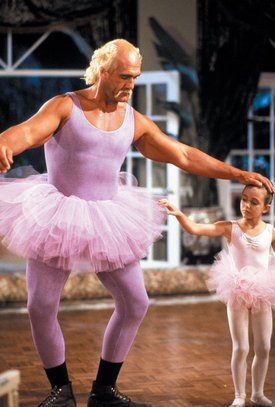 Recently, I went to a local Mexican food establishment to pick up dinner with a friend. This restaurant has a TV mounted to the wall, which is usually tuned to the Mexican Futbol teamÁ¢€â„¢s latest heartbreaking defeat, despite being two-goal favorites. This time, however, it was the classic movie-redub hour, and the classic movie was Mr. Nanny, starring Hulk Hogan. Being the film geeks that we are, we decided to discuss the dated look of the film by todayÁ¢€â„¢s standards. Meanwhile, one of the vatos next to us commented on how Á¢€Å“this is a funny movieÁ¢€ to his friend, making us look like total goobers.
Recently, I went to a local Mexican food establishment to pick up dinner with a friend. This restaurant has a TV mounted to the wall, which is usually tuned to the Mexican Futbol teamÁ¢€â„¢s latest heartbreaking defeat, despite being two-goal favorites. This time, however, it was the classic movie-redub hour, and the classic movie was Mr. Nanny, starring Hulk Hogan. Being the film geeks that we are, we decided to discuss the dated look of the film by todayÁ¢€â„¢s standards. Meanwhile, one of the vatos next to us commented on how Á¢€Å“this is a funny movieÁ¢€ to his friend, making us look like total goobers.
It might seem petty to discuss cinematic questions over the Univision Pelicula de Sabado, especially if said movie starred Hulk HoganÁ¢€â„¢s gleaming pectorals and bleached blonde mullet. However, using Zen philosophies, one could justify this as discussing the movie based on what it is not. Regardless, it did raise an interesting idea. Watch any movie from your childhood and try to make the argument that it doesnÁ¢€â„¢t look like it is from a certain era.
In fact, this is one of the most crucial arguments behind the philosophy of The Bigger Picture: A filmÁ¢€â„¢s potential for greatness is often related to its ability to cast aside the constraints of its time. This is not to say that a movie can embody the spirit of an era and not attain greatness in the long run. One example of a film like this is The Graduate — that movie had an absolutely huge cultural impact, and may not have been such a hit in todayÁ¢€â„¢s climate. However, films such as this one have a certain timeless quality to them that is difficult to define.
Yet, for all its strength to avoid aging, The Graduate still appears old from a purely visual standpoint. Mr. Nanny looks old now, though for a lot of us the 1990s were a formative decade. To start with, both of these movies were set in their own time period. The costumes and sets are all decorated using the styles of the time in which they were made. Hulk HoganÁ¢€â„¢s hairstyle is one that you would only have seen in a movie from 1993 (thank the Lord). Cars are especially important set dressing. You could have a modern building behind old cars and still fool audiences into believing the film is set in a non-contemporary time period.
Yet the crux of our question runs deeper than this. To fully understand my point, watch a period piece from the 1960s and then watch one from our current era. They still seem to be from different ages. Why is this? How could it be that two films about the same period in history can seem so different?
The first reason is an optical one. Film stock has changed (yes, most major movies are still shot on film). There are newer processing techniques, newer grain structures, and newer lights that the film reads differently. Photographers and cinematographers also know that every batch of film is going to have slight differences. This is why, for consistencyÁ¢€â„¢s sake, it is important to shoot on the same batch throughout a project. The look of a movie is so important. Movies from the 1990s do look different than the movies of today, just as popular music sounds different.
Yet all these visual clues only go so far. History has a way of compressing as we move further down the timeline. To use a photographic metaphor, we view our own past with a standard lens, while we view older generations with a telephoto lens, squishing foreground and background together. Two hundred years from now, the first century of cinema will be seen as remarkably similar, despite both the glaring and the subtle differences we can see.
So then, this entire argument can be reduced down to feeling. Spartacus and Gladiator are two movies with stories about slaves in ancient Rome who attempt to overthrow their masters, yet they feel different because their respective filmmakers were influenced by the morals and events of their own time. Everything the artist produces is indirectly related to something he or she has experienced. If a movie captures the imagination of its audience, it is because the viewers have lived through the same emotions as the filmmaker. Love is a universal emotion we all can relate to, yet it remains such a delicate subject to handle on film. Audiences can usually see through a forced or awkward love story. The love story of The Graduate remains one audiences can understand to this day.
Mr. Nanny, however, remains relegated to Spanish-language redubs.

![Reblog this post [with Zemanta]](http://img.zemanta.com/reblog_e.png?x-id=b78dc012-2777-4fb2-8a49-6e681141f7c5)

Comments